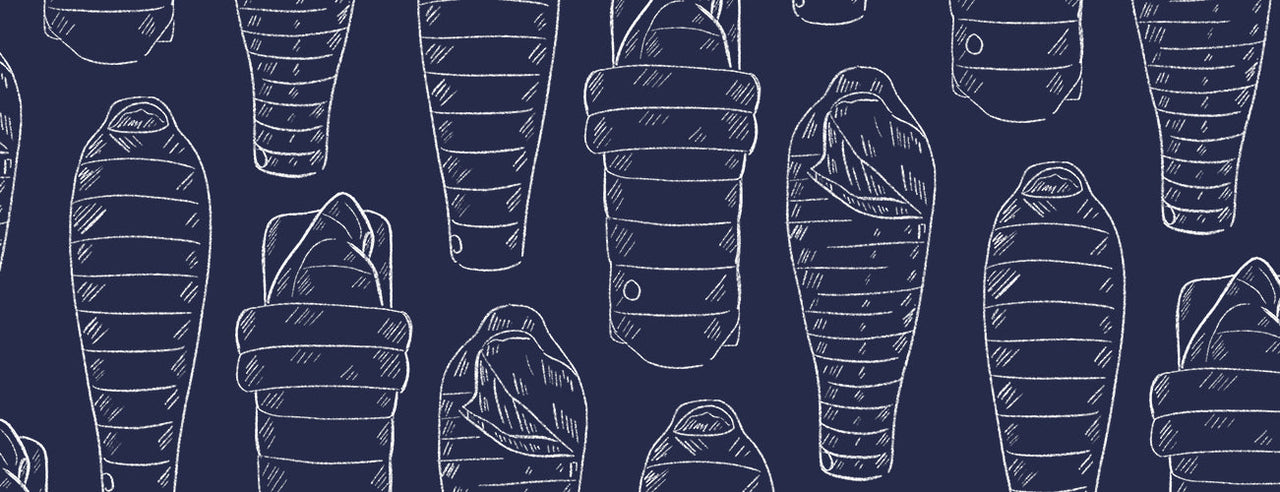Being cold at night is the worst.
We believe that laying down to sleep should be the coziest part of your day, not an 8-hour shiver-fest. There are so many factors that can influence how you feel in your sleep system. If you are taking your system to new lows or aren't as warm as you would like to be, troubleshoot your sleep system and try these tips for sleeping warmer.
Troubleshoot Your Sleep System
If you’ve had a cold night out, we want to figure out what factors were at play to prevent it from happening again. While environmental factors aren’t able to be accounted for, identifying any issues with your gear can make or break your night of sleep. Below are some of the common questions we ask to help identify which part of your sleep system may have been the weak spot.
Were you Cold All Over
1. Is your bag rated to the temperatures you are camping in?
The temperature rating that a men’s or unisex bag is given is based on the low end of the comfort spectrum. Women’s bags are rated more for comfort. For more information about ratings see our article on how to pick a sleeping bag (https://www.bigagnes.com/blogs/support/how-to-pick-a-sleeping-bag)
If you have a 45-degree sleeping bag and are expecting overnight low temperatures below that, adding a sleeping bag liner can help lower the overall rating and keep you warmer.
Another solution if you don’t want to add any ounces to your current setup is to add hot water to your water bottle. Sleeping with a source of warmth near your hands or feet can help your body maintain a warmer temperature while you sleep.
2. Is your bag the correct size for your height?
Sleeping bags are not a one-size-fits-all, fancy Snuggie. For maximum warmth for your backcountry bed, you want a bag that contours to your body without being too tight. The heat trapped between your body and the bag is what keeps you warm at night. The maximum user height can be found in the specs section for each bag.
You need enough room to create that pocket of warm air. A bag that is too small can constrict the down and inhibit the loft needed to trap your body heat. If your bag is too short, your feet pressing against the footbox will create a cold spot.
If you have too much room, it will take longer to efficiently heat the air pocket causing your body to expend more energy for less warmth. It will take longer to warm up the whole bag compared to one that is properly fitted. If the bag is too long, try to fill the extra space at the bottom with items like a jacket or extra layers.
3. Is your pad insulated for the season you are camping in?
Getting your body off the ground with a sleeping pad is crucial to maintaining warmth year-round. When your body comes into contact with cold ground, the ground acts like a vacuum, sucking the warmth out of you. Contact with cold ground will impact your body temperature more significantly than contact with cold air. If you have a pad rated for summer or 3 season camping but are trying to use it in colder conditions adding a closed cell foam pad such as our Twistercane BioFoam Pad between the pad and the ground adds an extra layer of insulation.
4. What layers are you wearing?
On a cold night, it can be tempting to hop in your bag with all your layers on, but this can lead to sweating eventually making you colder. It also prevents your body heat from warming the bag, ending up with a warm core, but cold hands and feet because your body heat is in your layers instead of the bag as a whole.
ISO testing standards assume the sleeper will be wearing only base layers and a hat for optimal performance. If you are a cold sleeper, try adding a pair of thick wool socks, gloves and a wool hat, paired with a wool base layer. Wool is exceptionally breathable and retains 70% of its warmth when wet (wet synthetics retain only 30% of their warming capacity and cotton has 0% warmth retention when wet).
5. What if you are camping in a humid area?
When camping in humid and moist areas you can have condensation build up in your tent and bag. Insulation can have reduced insulating power when wet and clumping together.
Air flow reduces condensation build up. Using a pad to keep you off the ground and ventilating your tent are ways to increase it.
Make sure to dry your bag thoroughly after each use in a humid climate. Tumbling the bag in a dryer can help ensure there’s no moisture still trapped in the insulation before long term storage.
6. What steps did you take before going to bed?
Have you emptied your bladder? Holding it in till morning will waste energy trying to keep the urine warm. Sleep better and warmer by letting it go and taking a bathroom break before crawling in for the night.
Did you eat or drink anything? Your body needs to be well hydrated to heat efficiently. We recommend drinking something hot to warm you up while hydrating you. Your body also needs fuel to create heat, fat burns slower so we recommend eating something fatty to hear your body efficiently.
Did you take any steps to warm up? Your body heat is crucial for heating your bag up. Sleeping bags trap your body heat and reflect it back to you. Crawling in your bag when you are already cold will take longer to warm you up. Do some sit-ups or jumping jacks to warm your body up. Make sure to warm up your hands and feet as your body will not be able to warm them up once you are asleep.
How early did you set up your bag? Insulation needs time to loft so lay your bag out when you set up camp. Give it a couple hours to loft or fluff it up as much as possible, so the insulation is at maximum thermal capacity when you are ready to hit the hay.
Cold Spots
1. Were the cold spots in your bag?
If there is a specific spot in your bag that feels colder than the rest, you will want to inspect the insulation. Shine or hold the area up to light to make sure the insulation is present in the area. If you’ve had any tears or physical damage to your bag, you’ll want to make sure to patch them as soon as possible to avoid losing insulation.
2. Is your bag clean?
Dirt, sweat and oil can cause your bag’s insulation to clump and can be creating cold spots and impacting your bag insulation's ability to loft. You can get your bag warm and fluffy by washing it after extensive use.
3. Were the cold spots in your pad?
If your pad is where you are losing heat be sure to check the insulation to make sure it is functioning properly. The best way to check is to fully inflate the pad and shine or hold light behind it. This will allow you to see any insulation clumps or shifts in the pad that may need to be addressed.
4. Is heat escaping through your head?
A hat is your quickest fix to trap more heat. Up to 50% of your body heat is lost through your neck and head. If you can sleep in a hat, you will be amazed by what a difference it makes. Do not burrow your head deep down in your sleeping bag, the moisture from your breath will wet your bag and make you even colder.


 English (EUR) | EN
English (EUR) | EN 